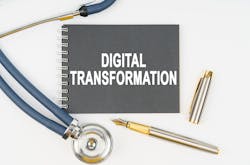Michael Minear, senior vice president and CIO for Lehigh Valley Health Network (LVHN) in Pennsylvania, has seen digital transformation accelerate dramatically during the pandemic, including innovations such as the recent deployment of a mobile app to help families follow a patient's progress in the emergency room. No matter what happens after the pandemic, “I don't think we're ever going to go back to not being as digital as we are, and I think that's a good thing,” Minear said.
LVHN is the first U.S. health system in the U.S. to deploy the new Vocera EASE ER app that allows families to follow a loved one’s emergency room progress on their mobile phone. It is also the first to integrate the cloud-based app with its electronic health record system.
Minear said LVHN has been using the ER app only a little over a month, but they had deployed the EASE app first in surgery units and then in a number of inpatient units where people are staying longer than a day or two. “In all cases before the ER module, there was never an interface with Epic, and we didn't need one,” he said, “but with this one, we really needed the interface. And I think as EASE became part of Vocera, they got a lot more depth from Vocera on how to do interfaces.”
He said the scale and pace of clinical work in the ER made the Epic interface important. As events are happening, they are noted in the EHR and the information is automatically interfaced to the EASE ER app, so the staff doesn't have to send notes; they are generated via automation. Examples of 25 automated messages include updates on room assignments and scheduled tests. To enhance security, messages sent disappear after 60 seconds of screen time, Minear said, and nothing is saved on the recipients’ mobile devices.
The project went live on Oct. 6, and more than 2,600 messages were sent in the first week of operation to loved ones in 11 states as far away as Hawaii, California and Florida. Plans include offering messaging in Spanish and other languages.
After piloting the app’s usage in the Lehigh Valley Hospital–Cedar Crest ER, LVHN has plans to roll it out across all 10 of its hospitals. The app is important, Minear said, because even after some hospital entry restrictions have been lifted, some people are hesitant to bring family members into the ER, and sometimes the hospital might have to limit numbers of people accompanying patients.
During the height of the region’s initial pandemic surge in spring of 2020, Minear’s IT teams sprung into high gear to improve communication capabilities across its hospital campuses. “When we had to shut off visitors, it was really quite dramatic,” he said. “We were having a lot of very sick people and some dying, no different than a lot of other hospitals. Previously we had iPads in every room, but we literally didn't let them communicate with the outside world. That was the mindset pre-pandemic. Over a period of four or five days, we had our techs work around the clock to rebuild every iPad and add options like videoconferencing. We had a patient wake up after a long intubation use the iPad to call his family and tell them that he was alive. It was a big deal.”
When PPE was in short supply, the IT teams at LVHN also set it up so patients could use iPads to talk to a physician at the nursing station. “We actually removed the brains from the ventilators and used longer cabling and tubing to put the brain in the hall, so the nurses and doctors wouldn't have to put PPE on again to go in the patient room to look at the ventilator settings and make adjustments,” Minear said. “There were a lot of examples like that where we were doing things we would never have thought of before. We had to adapt.”
In addition, in about a week, LVHN moved about 3,000 people to remote work across the organization. The IT team has about 525 people and probably 40 to 50 percent of them — the analysts and programmers — worked from home, but the clinical engineering people and technicians never went home. “We still have a fair number of remote workers. Like most organizations, some of our teams will stay hybrid or remote.”
Minear said he has been a CIO for over 35 years. “I've never seen a challenge like this. I think the physician leaders and nursing leaders will say the same thing about how they have experienced the pandemic,” he said. “But in our case, I think we were lucky, and the EASE app is one example. We had secure texting deployed. We had the ability to do remote work with VPN and other technologies. And we actually had the ability to do pretty expensive video visits in Epic. To make all the changes necessary, they had people working 15 to 16 hours a day. “We had people who just burned the candle to get a lot of this stuff done, and I'm very proud of them. And we're not the only hospital to do that, but I think our teams were very successful in the pandemic.”


